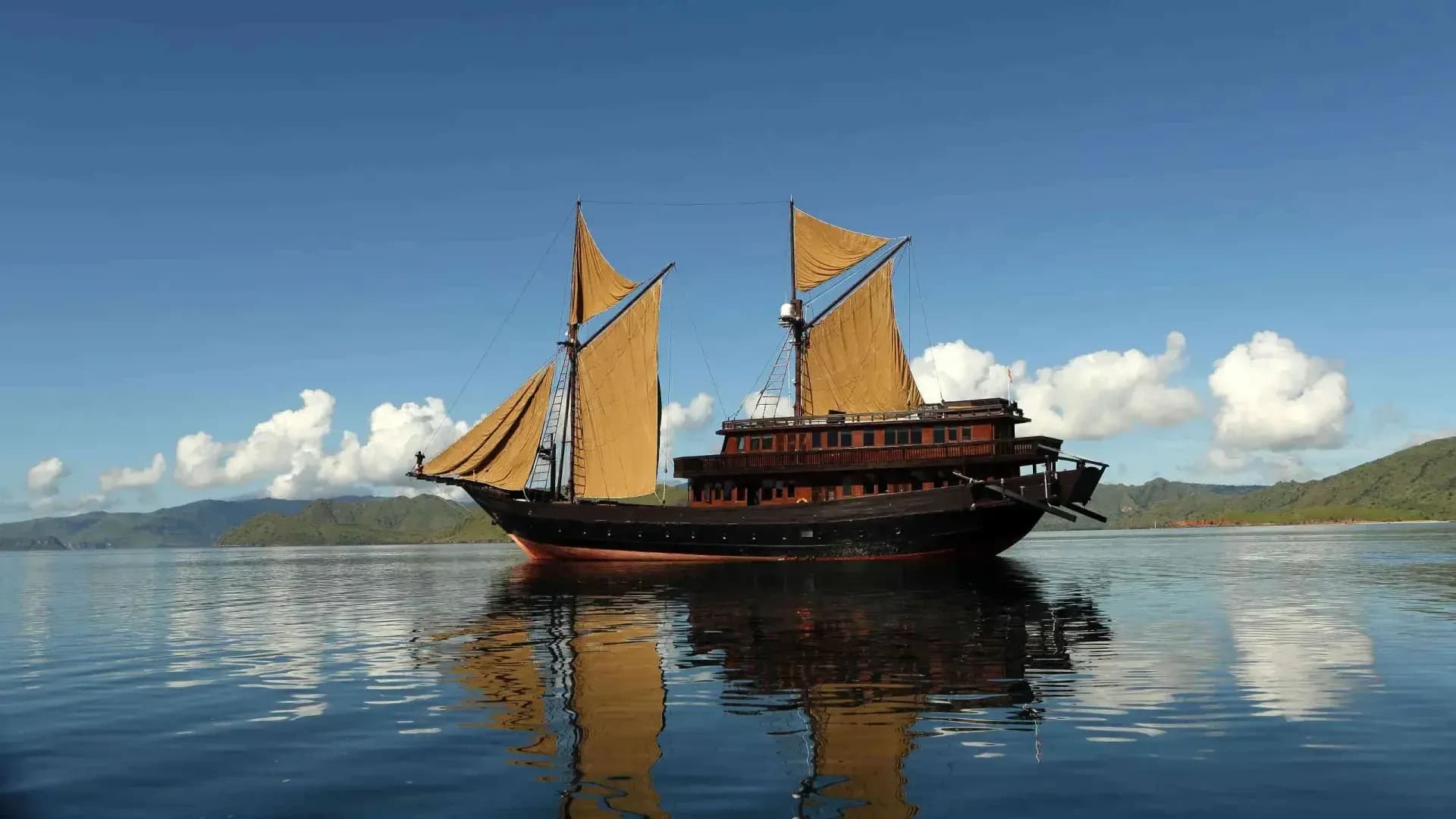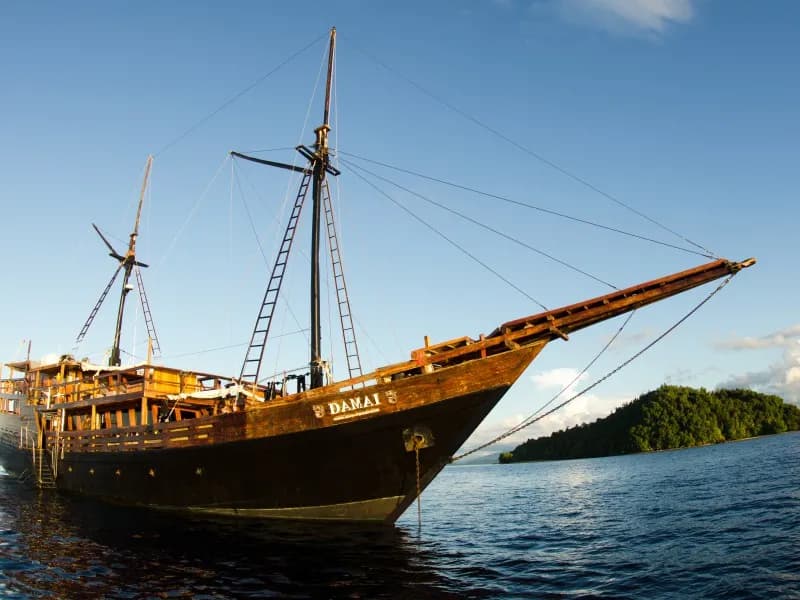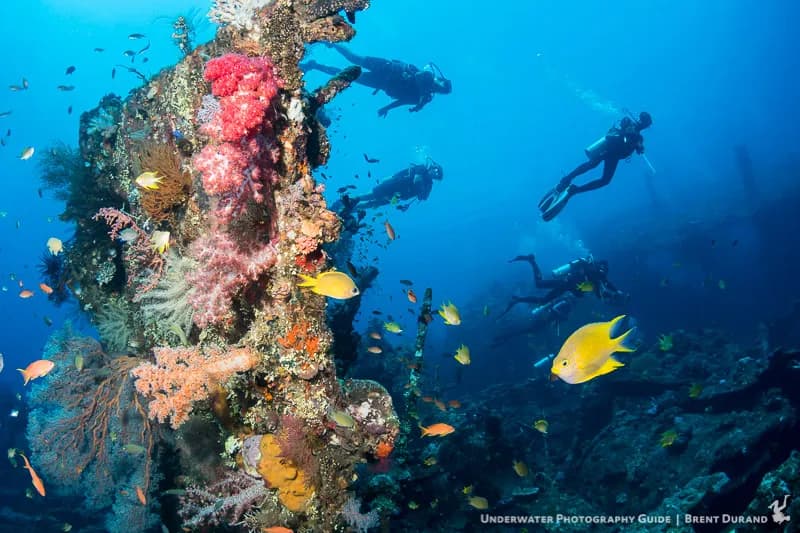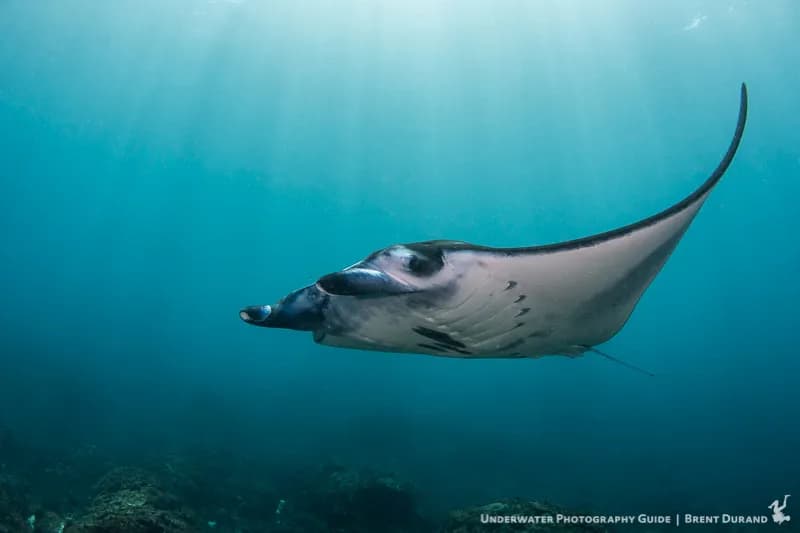
Scuba diving in Bali is exceptionally diverse and makes the perfect destination for a scuba diving safari. Unique macro critters, interesting wrecks, beautiful coral reefs, schools of tunas and barracudas, and bigger animals like mola molas and manta rays - Bali scuba diving has it all.
Scuba Dive Level
All Levels

Visibility
50 to 100 feet (15 to 30 meters)
Average Water Temperature
80
Manta Ray Encounters
Macro Critters
Scuba diving in Bali is exceptionally diverse and makes the perfect destination for a scuba diving safari. Unique macro critters, interesting wrecks, beautiful coral reefs, schools of tunas and barracudas, and bigger animals like mola molas and manta rays - Bali scuba diving has it all. Nusa Penida is one of Bali's diving hotspots, where divers flock to dive with manta rays and search for mola molas. Another renowned region for diving in Bali is the Northeast coast, which is famous for macro sites and the USAT Liberty shipwreck, but also boasts some great reef diving. The quiet Northwest is home to spectacular plunging coral walls and some fascinating macro sites - perfect for divers seeking exceptional diving away from the crowds.
Bali's diving diversity, combined with a friendly local population, relatively low cost, and a myriad of topside activities make Bali one of our favorite places in Indonesia to visit, for scuba divers and non-divers alike.
Bali is a small island in the country of Indonesia, and the only island where the population is primarily Hindu instead of Muslim. Bali is well-known for extremely friendly people, excellent food, a wide range of accommodations to suit all price levels, and specialized craftspeople making instruments out of materials such as teak, gold, silver, and bamboo.
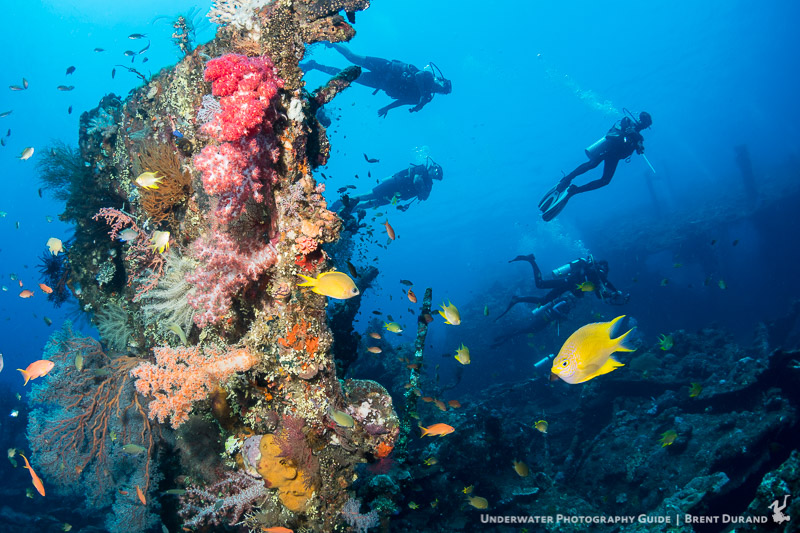
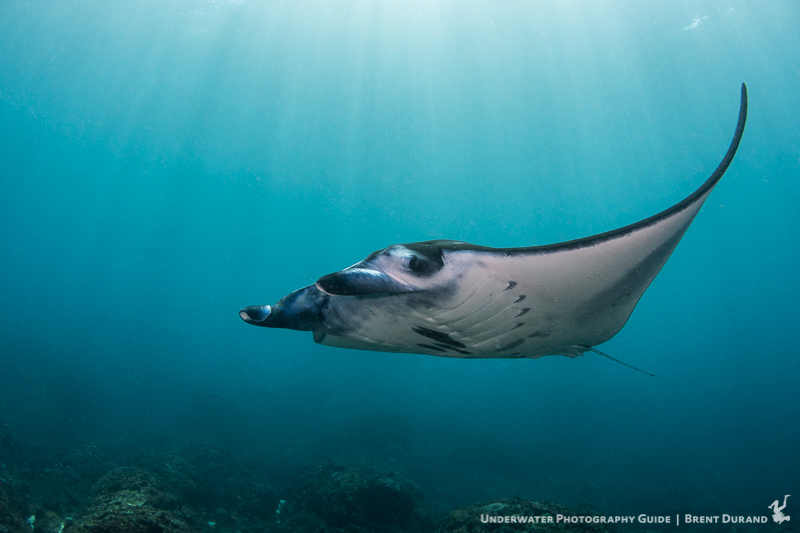
Bali's fascinating cultural experiences and impressive natural landmarks include temples, traditional dances, volcanoes, beautiful rice paddies, waterfalls, and countless other attractions. Underwater, you can find a plethora of big and small animals, ranging from mola molas and manta rays to tiny nudibranchs and pygmy seahorses. Underwater photographers will find ample opportunities to use their macro and wide-angle lenses.
If you enjoy a combination of scuba diving and cultural experiences, check out our guide to diving Papua New Guinea or Zanzibar, Tanzania & Kenya diving.
Scuba diving in Bali can be done from a dive resort, some liveaboards, or a dive safari. Some divers choose a liveaboard option that does not just include Bali but extends their itinerary to other nearby destinations like Komodo. These trips allow you to minimize your time in airports and maximize your time exploring Indonesia's underwater world. There is a wide selection of Bali dive resorts to choose from if you prefer to a land-based diving option. You can either stay in one location and make day trips to other nearby diving areas or embark on a Bali dive safari to spend less time in the car and experience all the best scuba diving in Bali.
Check out our Komodo Liveaboards, some of which also include Bali on their itinerary.
Interested in liveaboards?Let's help you get started with our Guide to Liveaboard Diving. You may also want to check out our list of the Best Liveaboard Destinations for Beginner Scuba Divers.
For other great dive resort areas, check out Cozumel, Mexico and Roatan, Honduras.
The question is not what can you see when diving in Bali, but what can you see? Located in the heart of the Coral Triangle, Bali boasts impressive marine biodiversity, with robust populations of reef fish, pelagic fish, turtles, macro life, and corals. Bali's diverse underwater topography includes shallow mucky bottoms, seagrass beds, sloping coral reefs, and coral walls plunging to depths exceeding 150 feet (50 meters).
Bali is one of the world top destinations for mola mola and manta rays. While the manta rays are consistently spotted at nearby Nusa Penida, mola mola are more elusive and are sought by divers visiting Bali during specific months when the water is colder (usually from July through September, although the season varies from year-to-year).
Diving Alor is also a great place to spot mola mola.
Going to the right Bali dive sites at the right depths can consistently produce larger animals such as Napolean wrasse, tuna, reef sharks, and schools of jacks, great barracuda, and giant trevally. Tulamben, Pemuteran, Menjangan Island, and Nusa Penida are great spots for encountering these animals.
Most Indo-Pacific macro critters have been found in Bali. Anilao and Lembeh offer slightly better critter diving, but with the right guide it can still be very good in Bali, and there are good critter sites in all of the major Bali diving regions.
.jpg)
.jpg)
.jpg)
Here is a list of some of the marine animals you can likely see in Bali:
For another great macro destination, check out diving in Anilao.
Bali dive sites are almost always along the shore or along one of the close smaller islands such as the Gilis - Tepekong, Mimpang, and Biaha - or Menjangan Island, Nusa Penida, or Nusa Lembongan. Boat sizes range from tiny jukungs that hold 2-3 divers and require gear to be donned in the water, to comfortable speedboats designed for scuba diving that can hold 8-12 divers.
Diver-to-guide ratios are generally small, and the guides are usually local Balinese or divers from other regions in Indonesia, such as Sulawesi. Dive sites in Bali range from walls to slopes, sandy to rocky, and include wreck dives, rubble, reef, black sand, and hard coral. Most Bail dive sites gradually drop in depth to well past 120ft deep, with prolific marine life at that depth and deeper. Since Bali has a large amount of marine life between 50 and 90ft depth, it is the perfect place to use nitrox, which is offered by many dive operators.
For more information, check out the recap of our trip to Bali and Lembeh.
Bali diving offers some of the best shore dives in the world, particularly in the northeast areas of Tulamben and Amed and the northwest areas in and around Pemuteran. In fact, there is in general excellent diving all along the entire northern and eastern coasts, resulting in many new and unexplored dive sites.
If you like shore diving, check out scuba diving in Bonaire or Bonaire's top dive sites.
There are many different areas to choose from for scuba diving in Bali, which is why we highly recommend a dive safari to visit them all. Some of the best dive spots in Bali are located off the east coast of the main island, and of the two small Bali islands called Nusa Lembongan and Nusa Penida. The northwestern coast of Bali, where Pemuteran and Menjangan Island are located, is also well worth checking out, and some of the best diving in Bali is done at the spectacular walls of Menjangan Island. In the following section, we have rounded up some of the best dive sites in Bali.
Tulamben is home to the USAT Liberty wreck, one of the most famous wrecks in the world. This is no ordinary wreck dive - it is a very large wreck lying at depths ranging from 20 feet (6 meters) to over 100 feet (30 meters), making it suitable for all levels of scuba divers and snorkelers. The Liberty is typically dived from shore, with an entry over volcanic pebbles and rocks that can be challenging in calm conditions and difficult when waves are present. Dive guides are accustomed to assisting divers with carrying cameras or equipment and lending a supportive hand when needed. Expect an amazing variety of big and small animals, including resident bumphead parrotfish, a resident school of jacks, and a resident great barracuda. Plan to do several dives at the Liberty wreck, including early morning "dawn" dives and night dives to witness unique marine life and behavior. Other nearby dive sites are also excellent, including the popular Drop-Off", and the world-famous muck site Seraya secrets. You can even try blackwater diving in Tulamben!
Candidasa is home to Bali's Gili Islands: Tepekong, Mimpang, and Biaha. These small rocky outcrops boast prolific fish life and the chance to encounter mola molas with fewer divers around (compared to the busy Nusa Penida). Tepekong can have exceptional fish life and visibility, and when the current picks up the schooling fish are quite a show. We recommend these sites for experienced divers who are comfortable in unpredictable and often changing currents, which can be fierce and include dangerous down currents.
Amed is 30 minutes east of Tulamben and is our preferred village to stay in because of the plentiful dining options. Along the road from Tulamben to Selang, there are numerous dive sites with muck, macro, walls, and healthy corals. Selang is a strong-current drift dive where hammerheads have occasionally been spotted. With the strong currents that can take unprepared divers far away from the island, we recommend you do not dive Selang unless you are with a trustworthy, experienced, and professional guide.
Nusa Penida is an island surrounded by fantastic dive sites full of healthy corals and strong currents. The sloping reefs are full of fish, turtles, and occasionally larger animals. Manta Point is home to the most reliable place to dive with manta rays as they visit a cleaning station. One of Balis most famous (and infamous) dive sites, Crystal Bay, is on Nusa Penida and is where the crowds go to seek the elusive mola mola. Pay close attention to the dive briefings at Nusa Penida, as currents demand the sites be dived in certain ways to avoid unfortunate (and sometimes tragic) consequences.
Padang Bai is a quaint little village home to the ferry terminal to Lombok. Visitors looking for more upscale accommodation can stay in nearby Candidasa, but Padang Bai has a much more relaxed and local feel. Padang Bai's dive sites are suitable for all levels and are also popular with snorkelers and are reached by traditional jukungs. You'll find a variety of fish and macro life, plus Bali's Gili Islands and Nusa Penida can be reached by speedboat.
Located in Gilimanuk next to the ferry crossing to Java, Secret Bay is well known for muck diving (and its chilly water temperatures). It's a shallow site that is often explored in longer dives, with the guide searching the trash on the bottom for weird and wonderful critters. This dive site is not for everyone: it's cold, dirty, and primarily of interest to serious macro lovers and underwater photographers. It does have some newly-installed dive infrastructure including showers and rinse tanks so you can clean the muck off before getting back in the car.
Part of West Bali National Park, Menjangan Island is dived by boats departing from Pemuteran, Sumberkima, and Pejarakan. The uncrowded dive sites boast incredibly healthy reefs, plenty of fish, and the most stunning coral walls in Bali. Divers enjoy consistently warm water year-round, spectacular topography, macro critters such as electric clams and pygmy seahorses, and larger animals such as reef sharks and schooling barracudas. Expect massive gorgonian sea fans, walls plummeting over 130 feet (40 meters), and visibility often exceeding 65 feet (20 meters). During your surface intervals, explore the white sand beach or rest in the bales (gazebos) at POS 1, watch the deer grazing, or photograph the gorgeous Ganesha statue at the island's main temple from your boat.
Bluewater Tip: Make the most of your daily National Park entrance ticket (IDR 200.000 or 300.000 on Sundays/holidays) by doing a 3-dive trip or a 2-dive trip followed by a guided tour of the National Park to see black monkeys, wild boar, the shy muntjac (barking deer), endangered Bali starling, and more.
A village on a quiet bay off the beaten tourist track, Pemuteran is home to a host of dive sites and coral restoration projects. All dive sites are within a ten-minute boat ride and offer a huge variety of nudibranchs, ghost pipefish, sea moths, and lots of fish. Night dives from shore provide the opportunity to see mandarinfish, frogfish, and more.
1. USAT Liberty Wreck - Tulamben's Liberty wreck is enormous, and definitely deserves several dives. It is usually dived by the shore. Super-strong Balinese women will carry your tank for you on their heads, sometimes even with a child being held in their other arm. Once near the wreck, you enter the water over rocky pebbles. If you are wobbly with a big camera, your dive guide will often carry the camera in/out of the water for you. Sunrise dives at the wreck are the absolute best, and well-deserving of an early wake-up call. Night dives are also fantastic at the Liberty, where large groupers will often startle you to be the center of attention in your torch beam!
2. The Drop Off - This beautiful coral wall in Amed offers a nice change of scenery from the muck diving the area is best known for. Photographers will have a tough choice between macro and wide-angle lenses here, with the opportunity to photograph gorgeous gorgonian sea fans or small nudibranchs decorating the reef. Suitable for all divers, the site generally has minimal current.
3. Seraya Secrets - Also located in Amed, this amazing muck diving site has easy conditions with a sloping black sandy bottom. Scour the mucky bottom for a huge variety of nudibranchs and a plethora of other small critters. Seraya Secrets is amazing for night dives when all the nocturnal critters come alive and give you a magnificent underwater show. The site can be dived from shore or boat, making it an easy addition to your itinerary diving in Northeast Bali.
4. Manta Point -Imagine yourself peacefully floating in the water while being surrounded by gentle curious manta rays. Thats what youll get when diving the Manta Point located in Nusa Penida. Mantas come here due to the cleaning station and closely pass by the divers. The dive site itself is shallow but sometimes can have strong surge and is inaccessible when the surface conditions are too rough due to its proximity to the rocky shoreline.
5. Crystal Bay - Mola Molas are the main highlight that attracts scuba divers around the world to visit this dive site at Nusa Penida. The high season for seeing Mola Molas is from July to mid-November. Sometimes they are also spotted outside the season but generally, mola molas stay deep and dont come close. The dive site is a bay with a white sand bottom and coral reef extending on either side. In high season, this site is exceptionally crowded, so we recommend experienced divers head to Candidasa to try their luck at spotting mola mola.
6. Napoleon Reef - This healthy reef in Pemuteran Bay shouldn't be missed during your trip to Northwest Bali. Best dived using Nitrox (but also great on air), this site boasts sprawling soft coral gardens carpetd with xenias, small coral drop offs, and is frequented by schooling fish, turtles, and white tip reef sharks. Advanced divers with Nitrox certification will experience the best parts of the site in the deeper areas, but the shallower reef is also full of exciting marine life.
7. Blue Lagoon - This Padang Bai dive site is great for beginners and is popular for training dives because the bay is protected and the coral is closer to the shore in shallower depths. The white sandy bottom dive site has great conditions with no current and amazing visibility. Sometimes the Spanish Dancer Nudibranch can be spotted here among squid, frogfish, rays, peacock mantis shrimp, eels, and many other colorful marine animals.
8. Eel Garden -This stunning wall at Menjangan Island drops to 160 feet (50 meters) and boasts healthy coral, massive sea fans, and loads of marine life. Pygmy seahorses, nudibranchs, frogfish, electric clams, and orangutan crabs are just some of the critters to spot on the wall. When currents are right, thousands of garden eels dance in the sandy bottom at the end of the wall (at about 65 feet), and divers can enjoy schools of barracuda, mackerel, and fusiliers in the blue. The shallow reef shelf is incredibly healthy and a great spot for snorkelers and novice divers. "This is my favorite dive site in all of Bali. If the conditions are just right, it is absolutely spectacular and rivals dive sites in Raja Ampat. I have dived it hundreds of times and always look forward to it." - Jenny, Bluewater Travel
From the United States: There are many international flights into Ngurah Rai International Airport (DPS) in Bali, available with a stop in major Asian cities like Tokyo (NRT/HND), Hong Kong (HKG), Taiwan – Taoyuan (TPE), Singapore (SIN), Bangkok – Suvarnabhumi (BKK), and some cities in China. From the East Coast, some flights stop in major Middle Eastern cities such as Doha (DOH) and Dubai (DXB).
From Europe: The most common hubs for international flights from European countries are located in the Middle East. Some of the more popular air companies with flights into Bali are Emirates, Qatar Airways, Etihad, and Turkish Airlines.
Once you landand get through customs:you can be in Tulamben in 3 hours or Pemuteran in 4 hours and it's best to arrange a private driver through your resort or travel agent for the most comfortable option for reaching these destinations. It's easy to get an official airport taxi upon arrival in Bali to reach nearby areas, but most dive resorts also offer to arrange an airport pick-up, either free of charge or with an additional cost. You may find comfort in knowing there is a driver waiting with your name on a sign after you exit customs instead of navigating the taxi queue after a long flight.
Getting Around: Most locals and long-term visitors are accustomed to riding a motorbike or scooter to get around. However, driving a scooter in Bali can be dangerous if you're not used to the local way of driving. Note that you are required to hold a motorcycle licence and international driving permit to drive a scooter in Bali and you should check your travel medical insurance coverage in case of an accident. Grab, a similar service to Uber, is available in some areas of Bali, but they are restricted in certain areas such as Ubud and do not travel to Pemuteran. We recommend sticking to the transfer options recommended by your dive operator or get an official taxi.
Traveling to other areas in Indonesia? Read our guide to flying domestically in Indonesia.
A popular term in Bali is dive safari, which means you stay in at least 2 different hotels in different regions to experience the best scuba diving in Bali. In our experience, your trip to Bali should involve at least 3 hotels one in the Pemuteran area, one in the Amed area, and one in South Bali (such as Sanur, Ubud, or Seminyak). If you are staying in South Bali to dive Nusa Penida, we recommend you stay in Sanur as that's where the dive shops are located. If you are staying in the south for just a night or two before your departure flights and want to see some sights and experience the local culture, Ubud is the place to be. Seminyak has many high-end accommodations but the traffic around Seminyak and Canggu is extremely congested. Aquamarine is one of the major tour operators with plenty of Bali dive safari options to choose from, but Bluewater's experts can help to arrange a customized safari through our many partners in Bali and our extenesive experience in the region.
Moving between hotels in Bali is painless; all you need to do is pack your suitcasee and check out. In addition, any drive in Bali is usually just a few hours in the comfort of a private air-conditioned vehicle and is extremely picturesque. Take advantage of the time you spend transfering from one location to another by doing so in daylight hours and stopping at sightseeing spots such as waterfalls, viewpoints, and temples. The driver may charge a bit extra for this service, but it is the best way to maximize your time on the island and see as much of it as possible. If you feel compelled to visit another location after Bali, Komodo is a great option for a liveaboard or land-based diving and is just a short flight away.
Find out more about dive resorts in Bali.
For another destination with gorgeous coral reefs, read about Cozumel here.
Bali diving conditions are excellent all year round, but we believe the best time to dive and visit is March-mid June and September-November. Bali gets crowded in the summer months, and December to February is the rainy season which may affect visibility at some of the dive sites, particularly those near rivers that run off into the ocean.
Tulamben and Pemuteran get less rain than other places in Bali and the visibility at Menjangan Island is typically unaffected during rainy season. July and August are the windy months in Northwest Bali, so boat rides to Menjangan Island are often very bumpy and wet and while the Island is always accessible, dive sites may be limited. There is still amazing diving, but if the wind is coming from the north, dive boats will visit the sheltered dive sites on the south and vice-versa.
August to September is the typical season for mola molas (sunfish) in Nusa Penida. (2023 update: mola mola season varies depending on the year. Contact us for the latest update on the best time to dive for mola mola).
We think a great time to visit Bali is during its shoulder season when there are fewer tourists from March-May & September-November. Learn more about why we love diving in Bali in September.
What can you do in Bali when you're not diving? Here is a list of ideas:
We love Bali and know you will, too, so here are some tips from our experts on the ground:
1. Culture: Show respect for the local culture at all times. It is offensive to dress for the beach when you are not at the beach, so if you are on the street, in a shop or restaurant, on a motorbike, or anywhere that is not a beach or swimming pool, you should be wearing a shirt and shorts/pants/skirt. We know it's hot, but it is not appropriate to walk around the streets topless or wearing a bikini. Confrontational behavior is also offensive, so do not yell, swear, or speak degradingly.
2. Language: In Indonesian, the letter "C" is pronounced as "Ch". The locals will be impressed if you pronounce it correctly (for example,Changu, not Kangu). Learn a few greetings and words: "Selamat pagi" (good morning), "selamat siang" (good day between 11:00-15:00), "selamat sore" (good afternoon after 15:00), "selamat malam" (good evening/night), "terima kasih" (thank you - Indonesian), "suksma" (thank you - Balinese).
3. Money: We prefer to withdraw cash from ATMs located inside banks or with security onsite. This is preferable to using questionable money exchange offices or streetside ATMs. Credit cards are not widely accepted and vendors may charge additional fees when you use them. Be prepared with cash, especially at small warungs (restaurants) and shops, especially outside the city areas. Local payment options are fairly advanced (QR codes, bank transfers, e-wallets), but international visitors have fewer options.
4. Tipping: While not expected, tipping is greatly appreciated. Balinese earn modest wages and tipping is a great way to express your gratitude for exceptional service. Note that western-style restaurants and hotel services often include a "service charge" on your bill, which is a gratuity.
5. Communication: Download WhatsApp to your phone before you arrive; everyone uses WhatsApp and it is the easiest way to communicate with most people and businesses. Cellular service is generally excellent and local SIM cards and data packages are inexpensive, just make sure your phone is not "locked" to a carrier as is common in the US.
6. Food: Try the local food (and not just nasi goreng). Bali is famous for babi guling - suckling pig cooked in a variety of ways. Northwest Bali is home to ayam betutu - a spicy and aromatic chicken served family-style with rice, peanuts, and sauces. Sate is another common dish - pieces of meat (usually chicken, pork, or goat) on small skewers grilled over coals with a delicious peanut sauce and rice. Meat is an important part of most balinese dishes, but there are also many delicious options for vegetarians. Gado gado is a salad prepared with beans, peanut sauce, and some combination of tempe, tofu, and/or boiled egg. Cap cay is a dish of vegetables in a savory sauce served with rice. There are too many delicious options to name here, but a word from the wise: you'll get the best local food from small roadside warungs, night markets, and food stalls - the busier the better.
7. Bonus tip: Read tip #1 again. I can't emphasize this point enough!
Download our full scuba gear guide to Bali, Bluewater Travel guests receive 10% OFF! Click the image below to download (PDF).
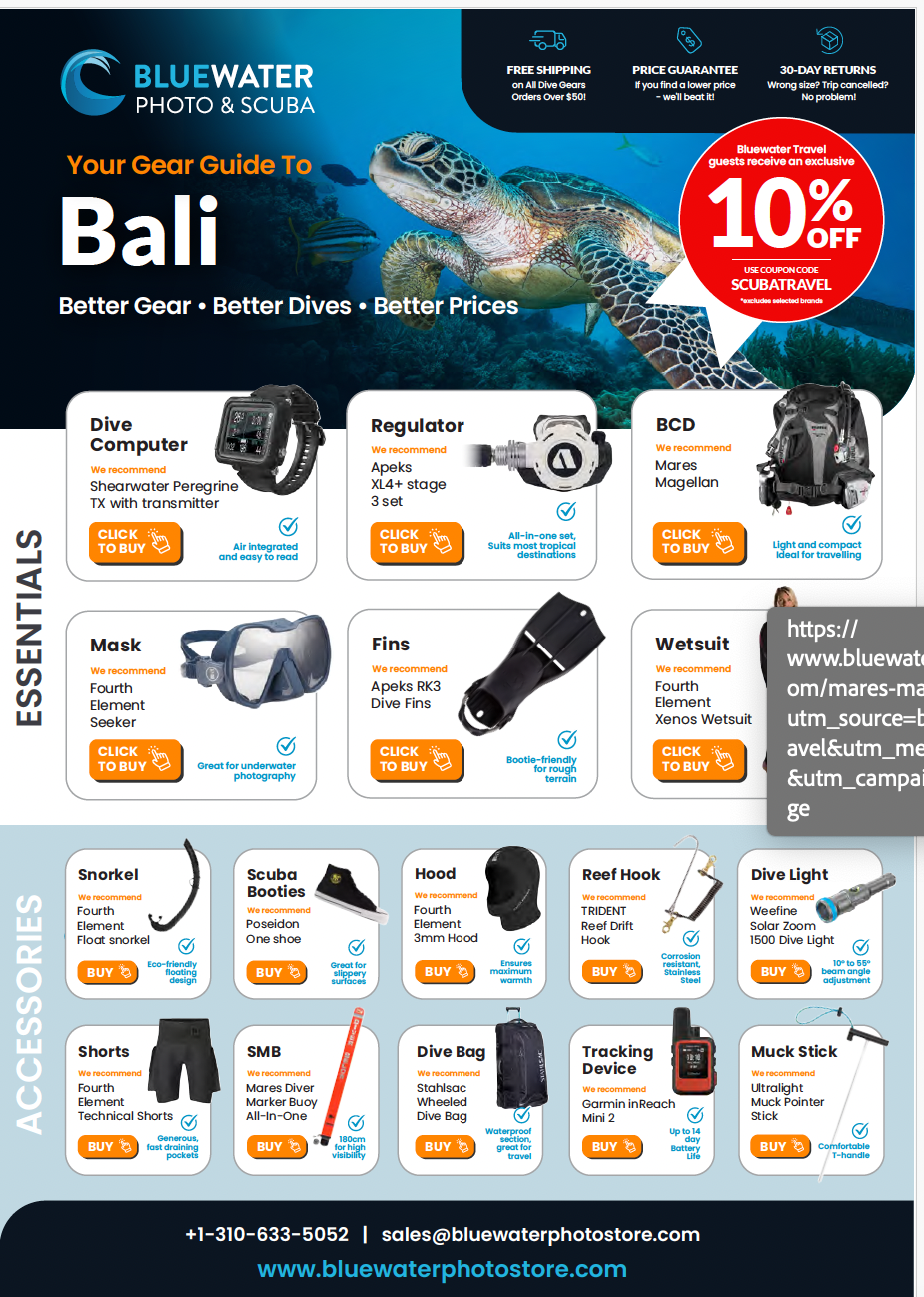


.jpg)
.jpg)
.jpg)

Explore Bali
